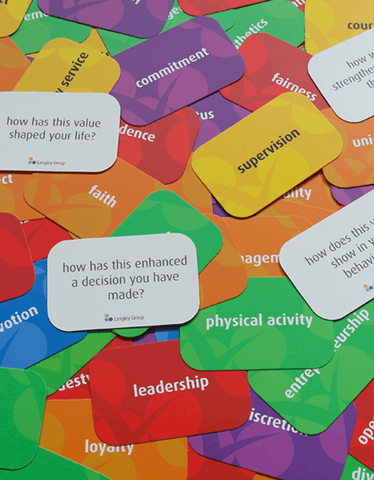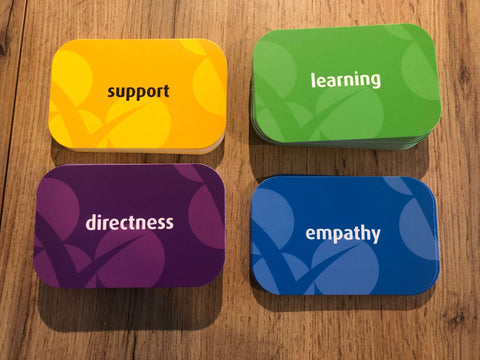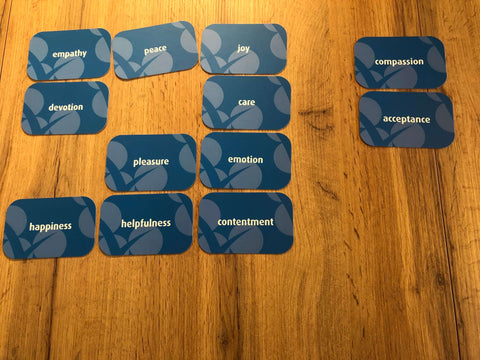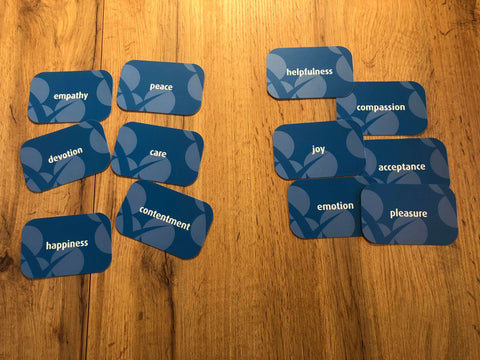Creative Workshop Exercises: Easy and Engaging Workshop Activities #14 Bring Workplace Values Alive with Langley Values Cards

Impact: Shared understanding of what is of core importance to individuals and the group as a whole about how they work, and the work itself.
Materials Needed: One pack of Langley Values Cards for each working group of 4- 8 people. A reasonably large table for each group so the cards can be spread out.
Remember, should you decide to buy one or more packs of cards, you can get 10% off your first shop order with a newsletter subscription
You can download this guide here
Professional Use:
Who is Bring Workplace Values Alive for?
This exercise will be useful for workshop leaders, team leaders and managers, organisational development practitioners and others who work with groups to help them identify or create a sense of their core values or a values statement.
How does it help with Bringing Workplace Values Alive?
Our values are deeply encoded in how we act and we are not always aware of them until they are offended. At which point we can experience very strong negative emotions of shock, outrage, unfairness, injustice, violation and so on. It is helpful to know and understand our core values to ensure that we, and those around us, can work to honour them.
By creating a space to explore and identify values in different work domains, this exercise enables people to access and share these deeply embedded values, thus creating greater team understanding and respect of what is important to individuals. At the same time the exercise enables the identification of common values and potentially the creation of a lived statement of team values.
Preparation
The colour coded cards represent values in six areas
Yellow – relationships/people orientation
Red – VIA strengths
Orange – Personal / individual
Purple – Professional Orientation
Blue – Emotional Orientation
Green – Links to Motivation
This means that in general you can select different sets of values to work with for different groups or purposes.
For our purposes today (values in the workplace) we are going to select the Yellow, Purple, Blue and Green sets to work with. If you have more limited time I would suggest just working with one colour set.
Ask each table to select these cards from the pack and to set the others aside.
How to run the exercise
Ask each table to take the blue set of cards and to spread them out between them, or to arrange them in a table. It’s important that all the words on the cards can be seen.
Ask everyone to think about the question: What is most important to me about how I feel at work? How do I need to feel, or what do I need to feel, to give of my best?
In turn, each person at the table is to select two of the cards and to explain briefly what they mean to them.
For example, someone might select Compassion and Acceptance and say, ‘I need to feel accepted for who I am to be able to be my best, and I need to feel compassion for our clients to feel I’m doing a worthwhile job.’
Put the first person’s two cards in a separate, but still on the table, space.
When the next person goes they also choose two cards, one or both of which can be the cards already selected.
If they select a new card, add it to the separate space. For example, here five people have taken a turn and there has been a lot of overlap in choice so the table now looks like this.
Once everyone at the table has completed the exercise, ask them to discuss the question
‘How shared are these values amongst us? What does this tell us about how we can make sure we all feel good at work?’
If you are working with more than one group, find a way to share the selections. Here are four ways you could do that:
Get the whole group to visit each table in turn as the people on each table explain their selection
Write all the words on a flip, ask groups to come up and put a tick next to each word that appeared in their selection
Ask each group to take a photo of their selection. Get them printed off and put them up next to each other
Ask each group to write their selection on a flip and stick them up next to each other
Then ask the large group, first ‘What do we see here, what do we notice about the selections made? What similarities or differences do you notice? Is there a particular selection you would like to inquire into?’
Once you have had this assimilating and connecting discussion, move onto the other two questions ‘How shared are these values amongst us? What does this tell us about how we can make sure we all feel good at work?’
Next, ask the groups to put the blue cards aside and set out the Yellow Cards so all the words can be seen.
This time ask the group the question ‘Given what is important to us about how we can be at our best at work, what are the two most important things for me about how we relate to each other, and other people around us, at work?’
Repeat the rest of the exercise as for the blue cards.
Follow the blue cards with the Green Cards, and this time ask the question. ‘So that I feel I can give of my best and have great relationships at work, how do I need to be motivated? That is, of these ideas here, which two really get my juices flowing, excite me about the possible nature of work? Motivate me?’
Repeat the rest of the exercise as for the blue cards. Be aware, this is the biggest set of cards so far and so this section of the exercise may take longer as people take more time to select from amongst the many options.
Finally, ask the group to put the other cards aside and to set out the purple cards so all the words can be seen. This time the question is ‘When I’m working, what are the two things I value most highly, that are most important to me?’
Repeat the rest of the exercise as for the blue cards.
You can round up the exercise here by getting the groups to reshuffle so they are working with the minimum number of people they have already worked with. Then ask them to discuss. ‘What have we learnt here today about what is important to us as a group?’
Take feedback on that, then, you might like to ask, ‘How do I feel differently about us as a group from when we started this exercise?’
Extensions of the exercise
Extension one: Exploring the meaning of the words to people in more depth
If you have plenty of time, or you choose to work with just one set of values, you can extend the exercise by asking people after they have given their brief explanation of their choice to expand on it.
One way to do this is to get someone else in the group to say, ‘Tell me more about that. Can you share an example of when you felt really (fill their word choice in here), or (fill their word choice in here)?
This is to encourage the telling of stories. Stories, lived examples, create greater depth of meaning and resonance amongst the group. These stories illuminate ‘values-in-action’, which do sometimes differ from our espoused values. Embedding values in stories can help people identify the values they actually live by.
You can build on this by encouraging sharing of a few of the ‘values-in-action’ stories at the larger group share-out time. This encourages a greater shared understanding of what ‘living our values’ might look like.
Extension two: Creating the basis for a values statement
When the exercise above is completed, you could work to create a values statement.
For example, you could divide the group into four and give each group one of the sets of values to wrangle into a couple of statements, using KEY words, but not necessarily all the words, that have emerged in the exercise.
For example, the group wrangling the blue cards output into statements might suggest
When we’re at work, it’s important to us that we help each other feel accepted and joyful. We do this every day by revelling in our diversity and highlighting and sharing and celebrating our moments of joy at work.
When we are with clients, empathy and compassion are our first priorities as we work with them to help them experience moments of pleasure and move forward in their lives.
Once each table has produced their statements, bring them all together so the whole group can look at them.
At this point I would suggest just making sure that everyone is happy with the general sentiments expressed, doesn’t feel anything very important has been overlooked. They may have some suggestions for improving the wording, so I might ask
Is there anything important from our discussion today that you feel is not yet represented in our statements?
What suggestions, if any, do you have for making these statements an even better reflection of our discussions?
Then, when the moment feels right or time runs out, I might ask ‘Are we happy as a group to let a few people refine this into our values statement?’
Assuming the answer is yes, the last step is to ask for a few volunteers to do that. At this point the wordsmiths can step forward. Ensure that their final version is shared with the group for group endorsement before it becomes official.
The Langley Value Card packs featured here are all available at the Positive Psychology Shop. A discount of 10% is available to new newsletter subscribers
If you have any queries about the exercises as described, please contact Sarahlewis@acukltd.com. We will publish any queries and answers in the next newsletter to the benefit of all.
Please feel free to share the link to this page with any colleagues you feel may be interested. Or, direct them to the newsletter subscription page where they can find out about the newsletter service and subscribe for free.
Please also feel free to add a link to this blog and/or our shop to your website if you think it might add value to your website visitors.





